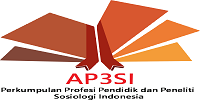Author Guidlines
- The article must be an original piece of work, has novelty thought and significant impact to Education of Sociology and Anthropology, and also has not be published or not being submitted to publish on another journal.
- The article can be written in Indonesian language or English
- The article may form of research findings, paperwork, and review of theories or methodology, review of policies or educational phenomenon.
- The number of the words in the article around 4.500 words and must not more than 6.000 words. It is excluding the bibliography and footnotes. Entries must be in 11-point Callisto MT and single spaced.
- If the article is written in Indonesian language, the abstract should be typed in Indonesian language and English. Meanwhile, if the article is written in English, the abstract should be typed in English only.
- The abstract ranged 150 - 250 words (approximately 1,100 to 1,450 characters including the spaces) and contains of one paragraph only which describes the essence of the entire content of the article clearly and completely. Entries must be in 10-point Callisto MT and single spaced. Please include 3 to 6 words of the keywords.
- Journal article should be sent through OJS (Open Journal System) by this website. Author(s) needs to register online by creating an account (username & password on this website before uploading article, to create an account (username & password on this website.
- Reference, citations in the text, footnotes should be written by using Mendeley Manager References in APA (American Psychological Associations) style 6 th
- Author(s) profile (full name, affiliation, and e-mail address) is not included in the text when submitting so that the reviewers perform double blind review.
- Author(s) must pay attention to various points listed in publication Ethics of the article to be delivered.
The Guidelines for the Manuscript Body Text
THE TITLE OF THE MANUSCRIPT:
- The Title of article reflects the main topics of article. It must be coherent, straightforward, and contain the main variables of the research.
- The title no more than 20 words.
- Article should be started by the title of the article followed by authors name and affiliation address and abstract. Authors name must be attached after the title of the article.
ABSTRACT:
- The abstract is summary of the articles
- The abstract should only be typed in one paragraph and single space.
- The abstract should be typed as concise as possible and should be composed of problem statement, method, scientific finding results, and a short conclusion or IMRAD (Introduction, Method, Results, Analysis and Discussion-conclusion).
- The abstract should tell the prospective reader what you did and highlight the key findings. Avoid using technical jargon and uncommon abbreviations. Use words which reflect the precise meaning, Cites no references.
INTRODUCTION:
- The introduction must contain (shortly and consecutively) a general background and a literature review (state of the art) as the basis of the brand new research question, statements of the brand new scientific article, main research problems, and the hypothesis.
- In the final part of the introduction, the purpose of the article writing should be stated.
- In the scientific article format, it does not allow to write down the references as in the research report. They should be represented in the literature review to show the brand new of the scientific article.
- The content of introduction is problem background, hypothesis (if any), significant idea to distinguish with the same issue has been published and purpose of research.
MATERIALS AND METHOD:
- The method is implemented to solve problems, including analytic methods.
- The methods used in the problem solving of the research are explained in this part.
RESULT AND DISCUSSION:
- This part consists of the research results and how they are discussed.
- The results obtained from the research have to be supported by sufficient data.
- The research results and the discovery must be the answers or the research hypothesis stated previously in the introduction part.
CONCLUSION:
- It is the final part containing conclusions and advice.
- The conclusions will be the answers to the hypothesis, the research purposes, and the research discoveries.
- The conclusions should not contain only the repetition of the results and discussions. It should be the summary of the research results as the author expects in the research purposes or the hypothesis.
- The advice contains suggestions associated with further ideas from the research.
REFERENCES:
- All the references that used in the article must be listed in this part.
- All the used references must be taken from primary sources
- These scientific journals published in the last ten years.
- Each article should have at least 10 references.
- The bibliography style of Jurnal Sikola: Jurnal Kajian Pendidikan dan Pembelajaran is using American Psychological Association (APA) style 6 th Edition.




















